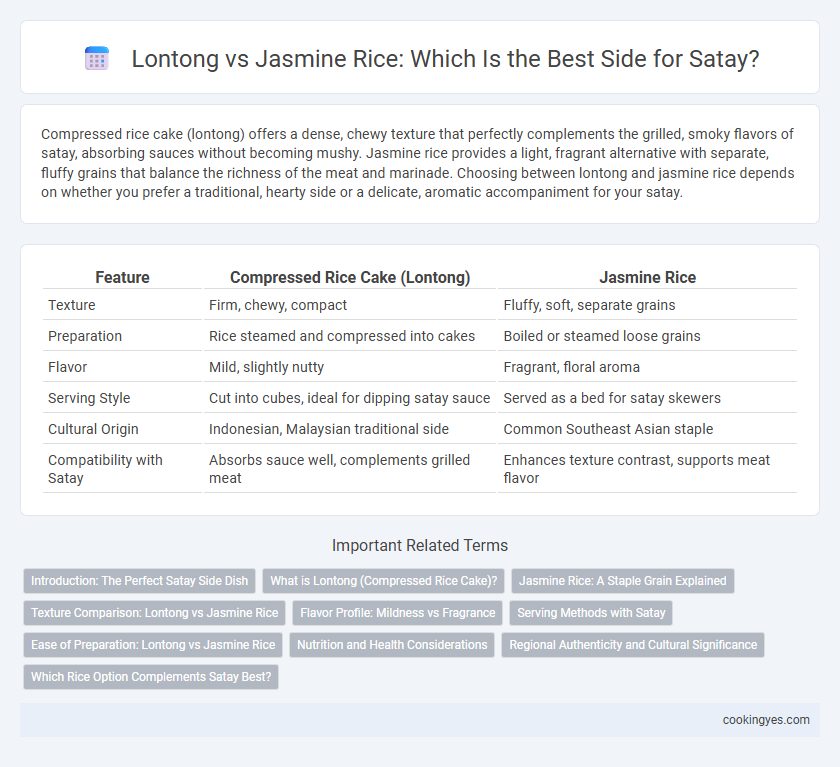Compressed rice cake (lontong) offers a dense, chewy texture that perfectly complements the grilled, smoky flavors of satay, absorbing sauces without becoming mushy. Jasmine rice provides a light, fragrant alternative with separate, fluffy grains that balance the richness of the meat and marinade. Choosing between lontong and jasmine rice depends on whether you prefer a traditional, hearty side or a delicate, aromatic accompaniment for your satay.
Table of Comparison
| Feature | Compressed Rice Cake (Lontong) | Jasmine Rice |
|---|---|---|
| Texture | Firm, chewy, compact | Fluffy, soft, separate grains |
| Preparation | Rice steamed and compressed into cakes | Boiled or steamed loose grains |
| Flavor | Mild, slightly nutty | Fragrant, floral aroma |
| Serving Style | Cut into cubes, ideal for dipping satay sauce | Served as a bed for satay skewers |
| Cultural Origin | Indonesian, Malaysian traditional side | Common Southeast Asian staple |
| Compatibility with Satay | Absorbs sauce well, complements grilled meat | Enhances texture contrast, supports meat flavor |
Introduction: The Perfect Satay Side Dish
Lontong, a compressed rice cake, offers a dense, chewy texture that absorbs satay sauce beautifully, enhancing each bite with a subtle, mild flavor. Jasmine rice provides a fragrant, fluffy base that complements satay by balancing the sweetness and spice without overpowering the dish. Choosing between lontong and jasmine rice depends on the desired texture and how the rice interacts with the rich, savory satay sauce.
What is Lontong (Compressed Rice Cake)?
Lontong is a traditional Indonesian compressed rice cake made by boiling rice tightly wrapped in banana leaves, resulting in a firm, chewy texture ideal for absorbing satay's rich, savory sauces. Unlike aromatic jasmine rice, which is fluffy and fragrant, lontong offers a dense yet tender bite that complements the spiced meat skewers by providing a neutral, absorbent base. Its unique preparation and texture make lontong a popular satay side, enhancing the dish's overall balance and authenticity in Southeast Asian cuisine.
Jasmine Rice: A Staple Grain Explained
Jasmine rice, a fragrant long-grain variety, provides a fluffy and aromatic base that complements the rich flavors of satay, enhancing the overall dining experience. Unlike lontong, the compressed rice cake with a dense and chewy texture, jasmine rice offers individual grains that absorb satay's savory peanut sauce more effectively. This staple grain's delicate scent and light texture make it a preferred choice in Southeast Asian cuisine, especially when paired with grilled meat skewers like satay.
Texture Comparison: Lontong vs Jasmine Rice
Lontong offers a firm and compact texture that holds well against the rich, savory sauces of satay, providing a satisfying chew that contrasts with the tender, fluffy grains of jasmine rice. Jasmine rice delivers a light, aromatic experience with individual grains that complement the satay's marinade without overpowering the palate. The dense, slightly sticky consistency of lontong enhances the satay's robustness, while jasmine rice provides a softer, more delicate base for balanced flavor absorption.
Flavor Profile: Mildness vs Fragrance
Compressed rice cake (Lontong) offers a mild, neutral flavor that perfectly balances the rich, spiced satay, absorbing the sauce without overpowering the palate. Jasmine rice provides a fragrant, aromatic quality with subtle floral notes that complement satay's savory and smoky elements, enhancing the overall taste experience. Choosing between Lontong and Jasmine rice depends on whether a gentle backdrop or a fragrant accent is preferred alongside satay.
Serving Methods with Satay
Lontong, a compressed rice cake, is traditionally served sliced or cut into bite-sized pieces that soak up satay's savory peanut sauce, complementing the skewers with a firm texture that contrasts the tender meat. Jasmine rice, steamed to fluffy perfection, offers a lighter, separate-grain alternative that balances satay's rich flavors without absorbing sauces, allowing for a cleaner palate between bites. Choosing lontong or jasmine rice as a side impacts the overall satay experience by either integrating with the sauce or providing a neutral base to highlight the marinated meat's spiciness.
Ease of Preparation: Lontong vs Jasmine Rice
Lontong offers a convenient, pre-packaged alternative that requires minimal preparation, typically needing only gentle steaming or boiling to reheat, making it ideal for quick satay meals. Jasmine rice demands more time and attention, involving precise washing, soaking, and cooking to achieve the desired fluffy texture suitable as a satay side. Choosing lontong significantly reduces cooking complexity, enhancing efficiency without compromising the traditional satay dining experience.
Nutrition and Health Considerations
Lontong, made from compressed rice cake, offers a lower glycemic index compared to jasmine rice, promoting more stable blood sugar levels ideal for individuals managing diabetes. It also contains slightly higher fiber content, which aids digestion and enhances satiety when paired with satay. Jasmine rice, while aromatic and flavorful, has a higher glycemic load and fewer nutrients, making lontong a healthier side choice for balanced nutrition alongside protein-rich satay.
Regional Authenticity and Cultural Significance
Lontong, a compressed rice cake, holds deep cultural significance in Indonesian and Malaysian satay dishes, symbolizing traditional culinary heritage and regional authenticity. Its firm texture and subtle flavor complement the savory satay sauce, creating a harmonious balance unique to Southeast Asian cuisine. Jasmine rice, commonly used in Thai and Vietnamese satay variations, offers a fragrant, fluffy alternative that reflects the distinct cultural preferences and agricultural practices of those regions.
Which Rice Option Complements Satay Best?
Lontong, a compressed rice cake, provides a dense texture that absorbs satay's rich peanut sauce effectively, creating a harmonious bite. Jasmine rice, known for its fragrant aroma and fluffy grains, offers a lighter contrast that balances the satay's bold spices without overpowering. Choosing between lontong and jasmine rice ultimately depends on whether a chewy, sauce-soaking accompaniment or a fragrant, subtle base is preferred to complement satay best.
Compressed Rice Cake (Lontong) vs Jasmine Rice for Satay Side Infographic

 cookingyes.com
cookingyes.com